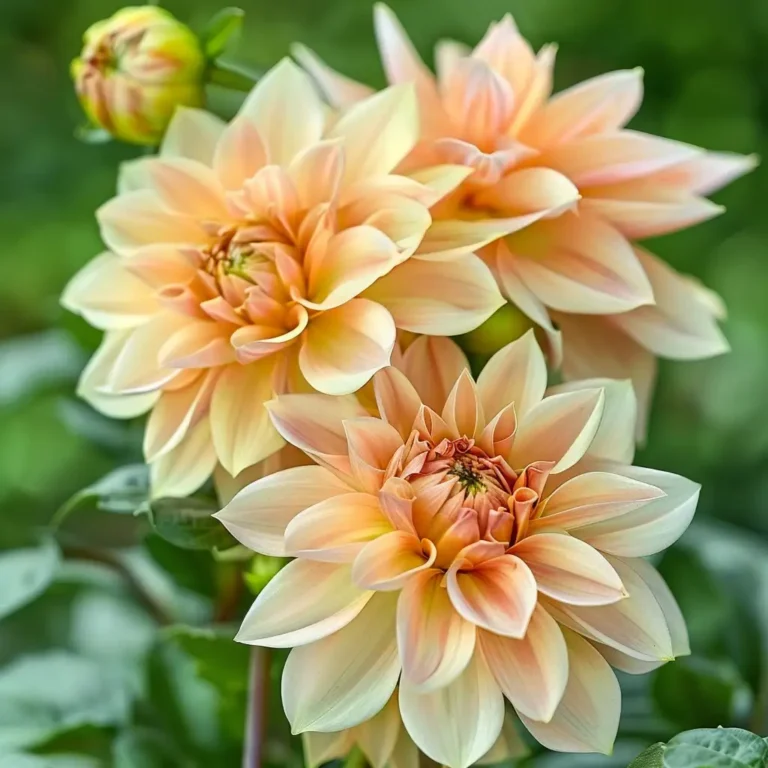Introduction
The Peach Dahlia (Dahlia Pinnata) is a captivating flower known for its stunning beauty and vibrant hues. With a rich history and various benefits in gardening, this flower has become a favorite among garden enthusiasts. Understanding its growth requirements and care will help you cultivate these blooms successfully.
Botanical Description
Dahlia Pinnata, commonly known as the Peach Dahlia, belongs to the Asteraceae family. It boasts large, round flowers that can reach up to 12 inches in diameter. The petals are arranged in a symmetrical pattern, creating a mesmerizing visual appeal.
Physical Characteristics
- Size: Up to 4 feet tall
- Color: Various shades of peach and pink
- Shape: Round, layered petals
History and Origin
Native to Mexico and Central America, Dahlia Pinnata has been cultivated since the 16th century. It was introduced to Europe in the 18th century, where it quickly gained popularity for its ornamental value.
Types and Varieties
There are numerous varieties of Dahlia Pinnata, each with unique characteristics. The Peach Dahlia variety stands out for its distinctive peach-colored petals.
Unique Features
- Variety of colors: Peach, pink, and apricot hues
- Blooming season: Summer to fall
- Flower size: Large, showy blooms
Growing Conditions
For optimal growth, Peach Dahlias require specific soil, sunlight, and watering conditions. Proper care will ensure healthy and vibrant blooms.
Soil Requirements
- Type: Well-drained, fertile soil
- pH Level: Slightly acidic to neutral
Sunlight and Temperature
- Sunlight: Full sun (at least 6 hours per day)
- Temperature: Prefers temperatures between 60-70°F
Watering Needs
- Frequency: Regular watering, keeping soil moist but not waterlogged
- Method: Deep watering at the base of the plant
Learn more about growing Dahlias from the Royal Horticultural Society.
Planting and Propagation
Peach Dahlias can be propagated through seeds, cuttings, or tubers. Each method has its own set of guidelines for successful growth.
Methods of Propagation
- Seeds: Start indoors 6-8 weeks before the last frost
- Cuttings: Take 3-4 inch cuttings from healthy plants
- Tubers: Divide tubers in early spring before planting
Best Planting Practices
- Spacing: 18-24 inches apart
- Depth: Plant tubers 6-8 inches deep
Explore detailed Dahlia care guides from the National Gardening Association.
Care and Maintenance
Regular care and maintenance are crucial for keeping Peach Dahlias healthy and vibrant.
Pruning and Deadheading
- Pruning: Remove dead or damaged stems
- Deadheading: Regularly remove spent blooms to encourage new growth
Fertilization
- Type: Balanced, slow-release fertilizer
- Frequency: Every 4-6 weeks during the growing season
Pest and Disease Control
- Common Pests: Aphids, spider mites
- Diseases: Powdery mildew, root rot
- Prevention: Regular inspection and proper spacing for air circulation
Landscaping Uses
Peach Dahlias are versatile and can enhance various garden designs. They are perfect for borders, containers, and as companion plants.
Garden Design Ideas
- Borders: Plant along garden edges for a striking display
- Containers: Ideal for patio and balcony gardens
- Companion Plants: Combine with other perennials for a colorful mix
Benefits and Uses
Beyond their aesthetic appeal, Peach Dahlias play a significant role in gardens and floral arrangements.
Aesthetic Appeal
- Visual Impact: Large, colorful blooms
- Seasonal Interest: Flowers from summer to fall
Role in Pollinator Gardens
- Attracts Pollinators: Bees and butterflies are drawn to their vibrant blooms
Use in Floral Arrangements
- Cut Flowers: Long-lasting and eye-catching in bouquets
- Decorative Use: Perfect for centerpieces and event decor
Common Problems and Solutions
Despite their beauty, Peach Dahlias can encounter a few common problems. Understanding these issues and their solutions will help maintain healthy plants.
Common Pests and Diseases
- Aphids: Treat with insecticidal soap or neem oil
- Powdery Mildew: Prevent with proper spacing and air circulation
Troubleshooting Growth Issues
- Poor Blooming: Ensure adequate sunlight and proper fertilization
- Wilting: Check soil moisture levels and avoid waterlogging
FAQs
What are the ideal growing conditions for Peach Dahlias?
Peach Dahlias thrive in well-drained soil with full sun exposure and regular watering.
How often should Peach Dahlias be watered?
They should be watered regularly, keeping the soil consistently moist but not waterlogged.
Can Peach Dahlias be grown indoors?
Yes, with sufficient sunlight and proper care, Peach Dahlias can be grown indoors.
Conclusion
Cultivating Peach Dahlias (Dahlia Pinnata) can be a rewarding experience. With their stunning blooms and vibrant colors, they are a beautiful addition to any garden. Follow the guidelines outlined above to ensure your Peach Dahlias thrive and bring joy to your gardening endeavors.

